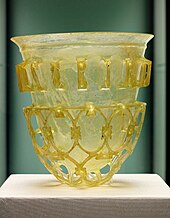History

Naturally occurring obsidian glass was used by Stone Age societies as it fractures along very sharp edges, making it ideal for cutting tools and weapons. Glassmaking dates back to at least 6000 years, long before humans had discovered how to smelt iron. Archaeological evidence suggests that the first true synthetic glass was made in Lebanon and the coastal north Syria, Mesopotamia or ancient Egypt. The earliest known glass objects, of the mid-third millennium BCE, were beads, perhaps initially created as accidental by-products of metalworking (slags) or during the production of faience, a pre-glass vitreous material made by a process similar to glazing. Early glass was rarely transparent and often contained impurities and imperfections, and is technically faience rather than true glass, which did not appear until 15th century BC. However, red-orange glass beads excavated from the Indus Valley Civilization dated before 1700 BC (possibly as early as 1900 BC) predate sustained glass production, which appeared around 1600 in Mesopotamia and 1500 in Egypt. During the Late Bronze Age there was a rapid growth in glassmaking technology in Egypt and Western Asia. Archaeological finds from this period include coloured glass ingots, vessels, and beads. Much early glass production relied on grinding techniques borrowed from stoneworking, such as grinding and carving glass in a cold state.
The term glass developed in the late Roman Empire. It was in the Roman glassmaking centre at Trier (located in current-day Germany), that the late-Latin term glesum originated, probably from a Germanic word for a transparent, lustrous substance. Glass objects have been recovered across the Roman Empire in domestic, funerary, and industrial contexts. Examples of Roman glass have been found outside of the former Roman Empire in China, the Baltics, the Middle East, and India. The Romans perfected cameo glass, produced by etching and carving through fused layers of different colours to produce a design in relief on the glass object.
In post-classical West Africa, Benin was a manufacturer of glass and glass beads. Glass was used extensively in Europe during the Middle Ages. Anglo-Saxon glass has been found across England during archaeological excavations of both settlement and cemetery sites. From the 10th-century onwards, glass was employed in stained glass windows of churches and cathedrals, with famous examples at Chartres Cathedral and the Basilica of Saint Denis. By the 14th-century, architects were designing buildings with walls of stained glass such as Sainte-Chapelle, Paris, (1203–1248) and the East end of Gloucester Cathedral. With the change in architectural style during the Renaissance period in Europe, the use of large stained glass windows became much less prevalent, although stained glass had a major revival with Gothic Revival architecture in the 19th century.
During the 13th century, the island of Murano, Venice, became a centre for glass making, building on medieval techniques to produce colourful ornamental pieces in large quantities. Murano glass makers developed the exceptionally clear colourless glass cristallo, so called for its resemblance to natural crystal, and extensively used for windows, mirrors, ships' lanterns, and lenses. In the 13th, 14th, and 15th centuries, enamelling and gilding on glass vessels was perfected in Egypt and Syria. Towards the end of the 17th century, Bohemia became an important region for glass production, remaining so until the start of the 20th century. By the 17th century, glass was also being produced in England in the Venetian tradition. In around 1675, George Ravenscroft invented lead crystal glass, with cut glass becoming fashionable in the 18th century. Ornamental glass objects became an important art medium during the Art Nouveau period in the late 19th century.
Throughout the 20th century, new mass production techniques led to the widespread availability and utility for bulk glass and its increased use as a building material and new applications of glass. In the 1920s a mould-etch process was developed, in which art was etched directly into the mould, so that each cast piece emerged from the mould with the image already on the surface of the glass. This reduced manufacturing costs and, combined with a wider use of coloured glass, led to cheap glassware in the 1930s, which later became known as Depression glass. In the 1950s, Pilkington Bros., England, developed the float glass process, producing high-quality distortion free flat sheets of glass by floating on molten tin. Modern multi-story buildings are frequently constructed with curtain walls made almost entirely of glass. Similarly, laminated glass has been widely applied to vehicles for windscreens. Optical glass for spectacles has been used since the Middle Ages. The production of lenses has become increasingly proficient, aiding astronomers as well as having other application in medicine and science. Glass is also employed as the aperture cover in many solar energy collectors.
In the 21st century, glass manufacturers have developed different brands of chemically strengthened glass for widespread application in touchscreens for smartphones, tablet computers, and many other types of information appliances. These include Gorilla glass, developed and manufactured by Corning, AGC Inc.'s Dragontrail and Schott AG's Xensation.
Comments
Post a Comment